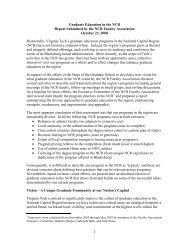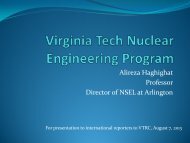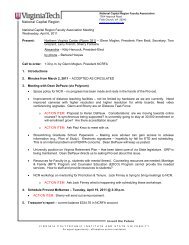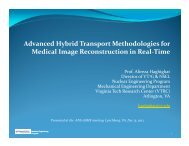Syllabus
Syllabus
Syllabus
You also want an ePaper? Increase the reach of your titles
YUMPU automatically turns print PDFs into web optimized ePapers that Google loves.
Particle Transport Theory, Methods and ApplicationsNSEG 6124I -- Catalogue DescriptionThe course discusses neutral particle interactions and related cross sections, LinearBoltzmann equation in “forward” and “adjoint” forms and their applications, perturbationand variational techniques for particle transport problems, different numerical methodsfor solving the linear Boltzmann equation, limitations of these methods for solving reallifeproblems, and discussion on parallel and serial implementations. Pre: 5124 (3H,3C).Course Number: 6124ADP TITLE: Par. Trans Theo., MTh. & Appl.II - Learning ObjectivesHaving successfully completed this course, the student will be able to:- Understand processes resulting in neutral particles interactions with matter, andassociated probability of interactions and differential and integral cross sectionsfor different types.- Effectively derive the necessary formulations for multi-variable differential crosssectionsand their use.- Understand the concept of multigroup cross sections and their generation methodsand related issues- Recognize the general Boltzmann equation, and understand its relation to theLinear Boltzmann Equation (LBE)- Derive the Linear Boltzmann Equation (LBE) (integro-differential form), andunderstand its limitations, impact/role of various terms, boundary conditions, andissues related to solving the equation- Derive the diffusion equation starting from LBE, and therefore understandsituations in which diffusion equation is invalid.- Understand the difference between neutron and gamma transport, and thereforethe terms in LBE- Derive the adjoint linear Boltzmann Equation using the adjoint function property- Derive the “importance” function equation, and understand its relation to the“forward” and adjoint LBE. understand its limitations, impact/role of variousterms, boundary conditions, and issues related to solving the equation- Understand the physical meaning of the importance function, and its use forsolving various real-world problems- Understand the concept of linear perturbation theory and its limitations throughderivation of a formulation for determination of change in reactor eigenvalue- Understand the concept of variational methods in reactor analysis, and derive aformulation corresponding to a detector response, and how the method facilitatereactor analysis
- Derive the integral from of LBE from the integro-differential form, andunderstand its use and limitations for solving problems- Derive analytical and semi-analytical formulations for integral LBE used forsimple problems.- Derive numerical formulations in 1-D using the Pn method, and understand itslimitations, boundary conditions, and difficulties in 3-D geometries- Derive the Simplified Pn (SPn) equations in multi-dimension geometries- Understand the concept of Double Pn (DPn), its use for derivation of DPnequations in 1-D, and its limitations in multi-dimensional geometries- Understand the concept of discrete ordinates (Sn), derive Sn equations in 1-DCartesian and curvilinear geometries based on various spatial differencingschemes, and for different boundary conditions- Derive the numerical formulation based on the method of characteristic forsolving the integral LBE- Discuss various hybrid techniques for solving real problems in real times- Understand the limitations of the Sn method, and issues related to its numericalaccuracy and convergence- Derive different acceleration schemes, and angular quadrature types- Understand the importance of parallel computing for solving LBEIII - JustificationNeutral Particle transport is encountered in all nuclear systems including reactors,detection systems for safety, security and safeguards, and radiation diagnostics, radiationtherapy, and nuclear medicine. This requires NSEG 5124 as a prerequisite in whichvarious concepts and formulations are introduced considering diffusion approximation. Itis intended primarily for those who would become specialists in various areas such asparticle transport methods and neutronics, reactor physics, radiation protection andshielding in nuclear systems, design of nondestructive detection and imaging systems,design of radiation-based medical devices. Mastery of this material provides thebackground for creating new concepts necessary for developing new systems anddevices, and development more effective computational methods and codes. Moreover,the extensive treatment of neutral particle transport computational methods also providesan important component of the background necessary for specialists in astrophysics, andthermonuclear plasmas.IV - Prerequisites and Corequisites5124
V - Texts and Special Teaching Aids- Lecture notes & handouts- “Computational Methods of Neutron Transport,” by E. E. Lewis and W.F. Miller,1984, American Nuclear Society (optional)- “Nuclear Reactor Theory,” by G.I. Bell and S. Glasstone, 1970, Van NostrandReinhold Company (optional)- “Methods for Steady-State Reactor Physics in Nuclear Design by R.J.J. Stammler andM.J. Abatte, 1983, Academic Press (optional)VI - <strong>Syllabus</strong>Topic% of CourseCross Sections 10The Linear Boltzmann Equation (LBE) and its application for neutral particle (i.e., neutron and gamma) transport 13The adjoint LBE, "importance" function and its applications 20Introduction to linear perturbation theory and variational methods for particle transport 13Integral form of the Boltzmann equation and its use for solving simple problems 7Numerical methods and their associated issues for solving the Boltzmann equation· Pn & Simplified Pn (SPn) 7· Double Pn (DPn) 3· Discrete ordinates (Sn) 13· Method of Characteristics (MOC) 3· Hybrid methods 3Introduction to acceleration methods for the Sn methods 2Introduction to techniques for generation of quadrature sets for the Sn methods 2Brief discussions on convergence, stability, and accuracy of the Sn methods 2Brief discussion on parallel computing algorithms for Sn methods 2










